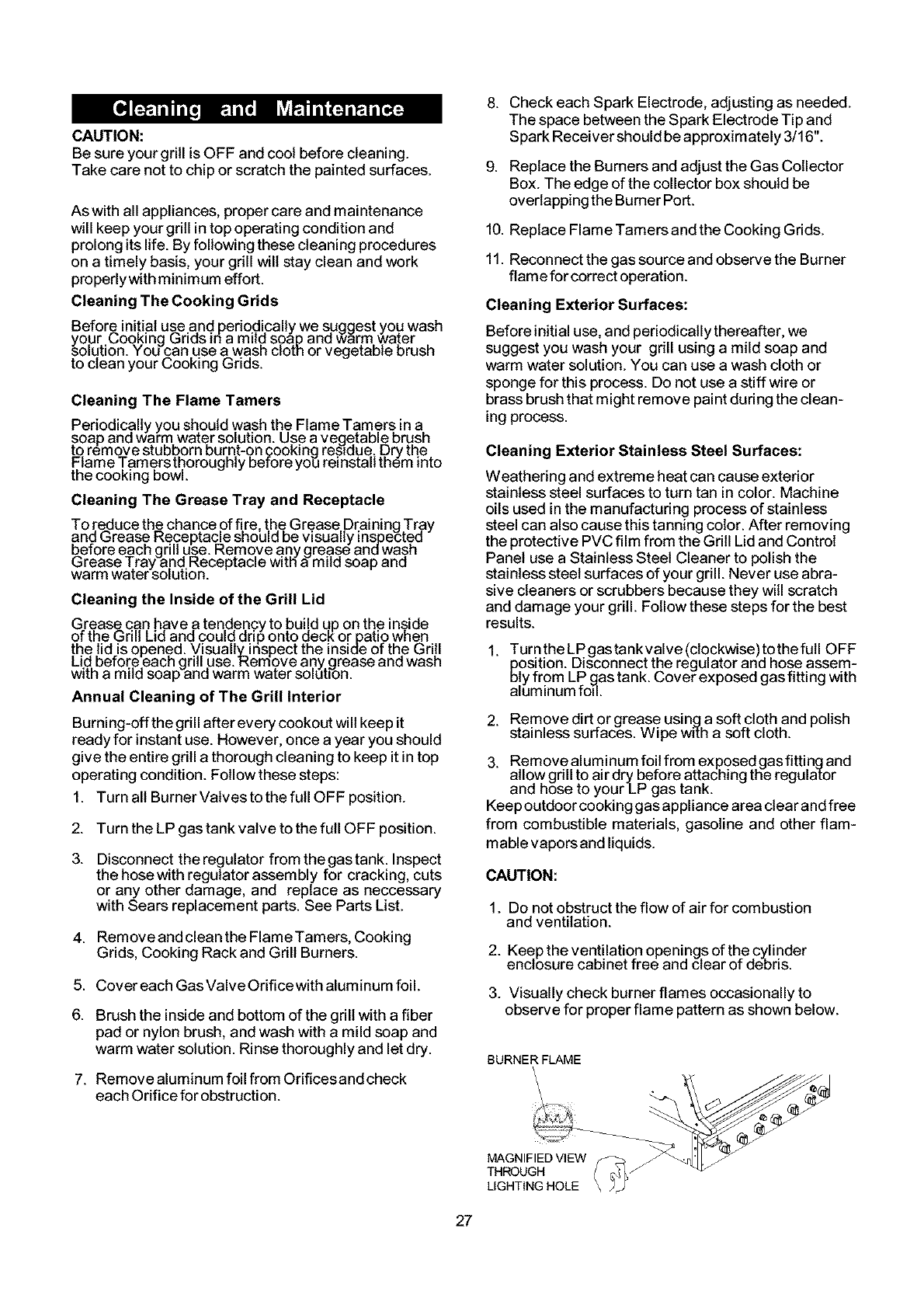Special offers from our partners!

Find Replacement BBQ Parts for 20,308 Models. Repair your BBQ today.

CAUTION:
BesureyourgrillisOFFandcoolbeforecleaning.
Takecarenottochiporscratchthepaintedsurfaces.
Aswithallappliances,propercareandmaintenance
willkeepyourgrillintopoperatingconditionand
prolongitslife.Byfollowingthesecleaningprocedures
onatimelybasis,yourgrillwillstaycleanandwork
properlywithminimumeffort.
CleaningTheCookingGrids
Before.ini,tialus.e.andperio.,dicallywesuggestyo.uwash
yourL,OOKIngL_rlasmamllasoapariawarmwater
solution.Youcanuseawashctotnorvegetablebrush
tocleanyourCookingGrids.
Cleaning The Flame Tamers
Periodically you should wash th,e Flame Tamers ina,
soap aria warm water solution, use a vegetable Drusn
to,remove stub.b,orn burnt-o,ncooking restd,ue..,Drythe.
tlamelamersmorougn_y Beforeyou reinsfall mem info
the cooking bowl.
Cleaning The Grease Tray and Receptacle
To reduce the chance ,off[re, t,he,Grease, p[aining Tray
ang urease Keceptacle snoulg Be ViSUally mspecteg
before each grill use. Remove any grease aria wash
Grease T.ray a,nd.Receptacle witl'i a mild soap and
warm water SOlUtiOn.
Cleaning the Inside of the Grill Lid
Gre,ase can have a ten,dency to bui!d u,pon the inside
of me L_riHLia ana cou_a grip onto geCKOrpado wnen
the !id.is opened..V,isually_.inspect the insiae of the Gri!l
Lla Before eacn grill use. Kemove any grease ana wasn
with a mild soap and warm water solut=on.
Annual Cleaning of The Grill Interior
Burning-offthe grill after every cookout willkeep it
ready for instant use. However, once a year you should
give the entire grill a thorough cleaning to keep it in top
operating condition. Follow these steps:
1. Turn all Burner Valves to the futl OFF position.
2. Turn the LP gas tank valve to the full OFF position.
3. Disconnect the regulator from the gas tank. Inspect
the hose with regulator assem bly for cracking, cuts
or any other damage, and replace as neccessary
with Sears replacement parts. See Parts List.
4. Remove and clean the Flame Tamers, Cooking
Grids, Cooking Rack and Grill Burners.
5. Cover each Gas Valve Orificewith aluminum foil.
6. Brush the inside and bottom of the grill with a fiber
pad or nylon brush, and wash with a mild soap and
warm water solution. Rinse thoroughly and let dry.
7. Remove aluminum foil from Orificesand check
each Orifice for obstruction.
8. Check each Spark Electrode, adjusting as needed.
The space between the Spark Electrode Tip and
Spark Receiver should be approximately 3/16".
9. Replace the Burners and adjust the Gas Collector
Box. The edge of the collector box should be
overlapping the Burner Port.
10. Replace Flame Tamers and the Cooking Grids.
11. Reconnect the gas source and observe the Burner
flame for correct operation.
Cleaning Exterior Surfaces:
Before initial use, and periodically thereafter, we
suggest you wash your grill using a mild soap and
warm water solution. You can use a wash cloth or
sponge for this process. Do not use a stiff wire or
brass brush that might remove paint during the clean-
ing process.
Cleaning Exterior Stainless Steel Surfaces:
Weathering and extreme heat can cause exterior
stainless steel surfaces to turn tan in color. Machine
oils used in the manufacturing process of stainless
steel can also cause this tanning color. After removing
the protective PVC film from the Grill Lid and Control
Panel use a Stainless Steel Cleaner to polish the
stainless steel surfaces of your grill. Never use abra-
sive cleaners or scrubbers because they will scratch
and damage your grill. Follow these steps for the best
results.
1. TurntheLPgastankvalve(clockwise)tothefull OFF
position. Disconnect the regulator and hose assem-
bly from LP gas tank. Cover exposed gasfitting with
aluminum fo_.
2. Remove dirt or grease using a soft cloth and polish
stainless surfaces. Wipe with a soft cloth.
3. Remove aluminum foil from exposed gasfitting and
allow grill to air drybefore attaching the regulator
and hose to yourLP gas tank.
Keep outdoor cooking gasappliance area clear and free
from combustible materials, gasoline and other flam-
mable vaporsand liquids.
CAUTION:
1. Do not obstruct the flowofair forcombustion
and ventilation.
2. Keep the ventilation openings of the cylinder
enclosure cabinet free and clear of debris.
3. Visually check burner flames occasionally to
observe for proper flame pattern as shown below.
BURNER FLAME
MAGNIFIEDVIEW _ /_l_ ./
THROUGH / _/ "_/
UGHT{NG HOLE \ J_
27


















